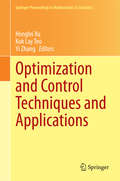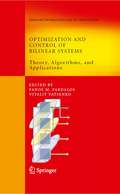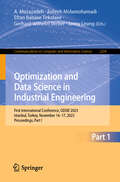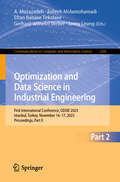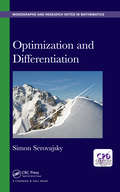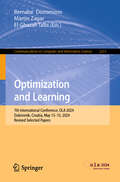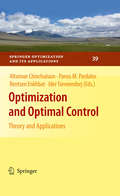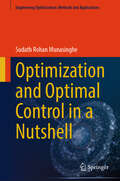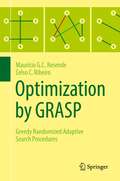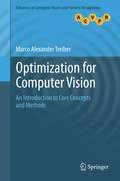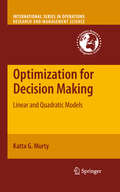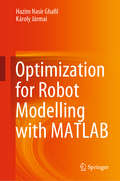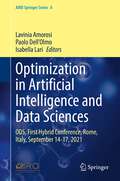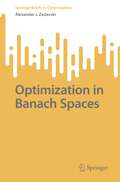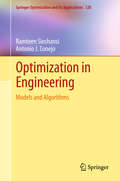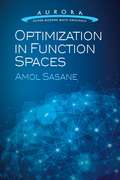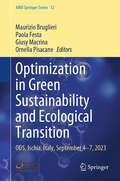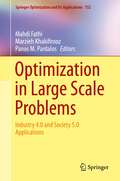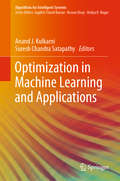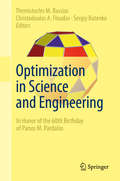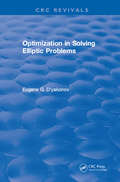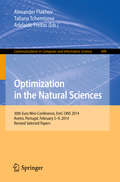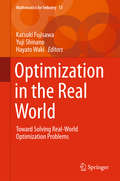- Table View
- List View
Optimization and Control Techniques and Applications
by Honglei Xu Kok Lay Teo Yi ZhangThis book presents advances in state-of-the-art solution methods and their applications to real life practical problems in optimization, control and operations research. Contributions from world-class experts in the field are collated here in two parts, dealing first with optimization and control theory and then with techniques and applications. Topics covered in the first part include control theory on infinite dimensional Banach spaces, history-dependent inclusion and linear programming complexity theory. Chapters also explore the use of approximations of Hamilton-Jacobi-Bellman inequality for solving periodic optimization problems and look at multi-objective semi-infinite optimization problems and production planning problems. In the second part, the authors address techniques and applications of optimization and control in a variety of disciplines, such as chaos synchronization, facial expression recognition and dynamic input-output economic models. Other applications considered here include image retrieval, natural earth satellites orbital transfers, snap-back repellers and modern logistic systems. Readers will learn of advances in optimization, control and operations research, as well as potential new avenues of research and development. The book will appeal to scientific researchers, mathematicians and all specialists interested in the latest advances in optimization and control.
Optimization and Control of Bilinear Systems
by Panos M. Pardalos Vitaliy A. YatsenkoCovers developments in bilinear systems theory Focuses on the control of open physical processes functioning in a non-equilibrium mode Emphasis is on three primary disciplines: modern differential geometry, control of dynamical systems, and optimization theory Includes applications to the fields of quantum and molecular computing, control of physical processes, biophysics, superconducting magnetism, and physical information science
Optimization and Data Science in Industrial Engineering: First International Conference, ODSIE 2023, Istanbul, Turkey, November 16–17, 2023, Proceedings, Part I (Communications in Computer and Information Science #2204)
by Gerhard-Wilhelm Weber Zohreh Molamohamadi A. Mirzazadeh Efran Babaee Tirkolaee Janny LeungThis two-volume set CCIS 2204 and 2205 constitutes the refereed proceedings of the First International Conference on Optimization and Data Science in Industrial Engineering, ODSIE 2023, held in Istanbul, Turkey, during November 16–17, 2023. The 33 full papers and 2 short papers presented in these proceedings were carefully reviewed and selected from 311 submissions. The papers were organized in the following topical sections: Part I: smart and intelligent transportation systems; machine/deep/reinforcement learning in industries; and advances of artificial intelligence/operational research tools in healthcare. Part II: technology, learning and analytics in intelligent systems; expert systems, decision analysis, and advanced optimization; digital transformation of supply chain and logistics systems.
Optimization and Data Science in Industrial Engineering: First International Conference, ODSIE 2023, Istanbul, Turkey, November 16–17, 2023, Proceedings, Part II (Communications in Computer and Information Science #2205)
by Gerhard-Wilhelm Weber Zohreh Molamohamadi A. Mirzazadeh Efran Babaee Tirkolaee Janny LeungThis two-volume set CCIS 2204 and 2205 constitutes the refereed proceedings of the First International Conference on Optimization and Data Science in Industrial Engineering, ODSIE 2023, held in Istanbul, Turkey, during November 16–17, 2023. The 33 full papers and 2 short papers presented in these proceedings were carefully reviewed and selected from 311 submissions. The papers were organized in the following topical sections: Part I: smart and intelligent transportation systems; machine/deep/reinforcement learning in industries; and advances of artificial intelligence/operational research tools in healthcare. Part II: technology, learning and analytics in intelligent systems; expert systems, decision analysis, and advanced optimization; digital transformation of supply chain and logistics systems.
Optimization and Differentiation (Chapman & Hall/CRC Monographs and Research Notes in Mathematics)
by Simon SerovajskyOptimization and Differentiation is an introduction to the application of optimization control theory to systems described by nonlinear partial differential equations. As well as offering a useful reference work for researchers in these fields, it is also suitable for graduate students of optimal control theory.
Optimization and Learning: 7th International Conference, OLA 2024, Dubrovnik, Croatia, May 13–15, 2024, Revised Selected Papers (Communications in Computer and Information Science #2311)
by Bernabé Dorronsoro El-Ghazali Talbi Martin ZagarThis book constitutes the refereed proceedings of the 7th International Conference on Optimization and Learning, OLA 2024, held in Dubrovnik, Croatia, during May 13–15, 2024. The 24 full papers presented here were carefully reviewed and selected from 64 submissions. They were organized in the following topical sections: synergies between optimization and machine learning; enhancing optimization and learning techniques; transportation and routing; and applications.
Optimization and Optimal Control
by Panos M. Pardalos Ider Tseveendorj Altannar Chinchuluun Rentsen EnkhbatOptimization and optimal control are the main tools in decision making. Because of their numerous applications in various disciplines, research in these areas is accelerating at a rapid pace. "Optimization and Optimal Control: Theory and Applications" brings together the latest developments in these areas of research as well as presents applications of these results to a wide range of real-world problems. This volume can serve as a useful resource for researchers, practitioners, and advanced graduate students of mathematics and engineering working in research areas where results in optimization and optimal control can be applied.
Optimization and Optimal Control in a Nutshell (Engineering Optimization: Methods and Applications)
by Sudath Rohan MunasingheThis book concisely presents the optimization process and optimal control process with examples and simulations to help self-learning and better comprehension. It starts with function optimization and constraint inclusion and then extends to functional optimization using the calculus of variations. The development of optimal controls for continuous-time, linear, open-loop systems is presented using Lagrangian and Pontryagin-Hamiltonian methods, showing how to introduce the end-point conditions in time and state. The closed-loop optimal control for linear systems with a quadratic cost function, well-known as the linear quadratic regulator (LQR) is developed for both time-bound and time-unbounded conditions. Some control systems need to maximize performance alongside cost minimization. The Pontryagin's maximum principle is presented in this regard with clear examples that show the practical implementation of it. It is shown through examples how the maximum principle leads to control switching and Bang-Bang control in certain types of systems. The application of optimal controls in discrete-time open-loop systems with the quadratic cost is presented and then extended to the closed-loop control, which results in the model predictive control (MPC). Throughout the book, examples and Matlab simulation codes are provided for the learner to practice the contents in each section. The aligned lineup of content helps the learner develop knowledge and skills in optimal control gradually and quickly.
Optimization by GRASP: Greedy Randomized Adaptive Search Procedures
by Celso C. Ribeiro Mauricio G.C. ResendeThis is the first book to cover GRASP (Greedy Randomized Adaptive Search Procedures), a metaheuristic that has enjoyed wide success in practice with a broad range of applications to real-world combinatorial optimization problems. The state-of-the-art coverage and carefully crafted pedagogical style lends this book highly accessible as an introductory text not only to GRASP, but also to combinatorial optimization, greedy algorithms, local search, and path-relinking, as well as to heuristics and metaheuristics, in general. The focus is on algorithmic and computational aspects of applied optimization with GRASP with emphasis given to the end-user, providing sufficient information on the broad spectrum of advances in applied optimization with GRASP. For the more advanced reader, chapters on hybridization with path-relinking and parallel and continuous GRASP present these topics in a clear and concise fashion. Additionally, the book offers a very complete annotated bibliography of GRASP and combinatorial optimization. For the practitioner who needs to solve combinatorial optimization problems, the book provides a chapter with four case studies and implementable templates for all algorithms covered in the text. This book, with its excellent overview of GRASP, will appeal to researchers and practitioners of combinatorial optimization who have a need to find optimal or near optimal solutions to hard combinatorial optimization problems.
Optimization for Computer Vision: An Introduction to Core Concepts and Methods
by Marco Alexander TreiberThis practical and authoritative text/reference presents a broad introduction to the optimization methods used specifically in computer vision. In order to facilitate understanding, the presentation of the methods is supplemented by simple flow charts, followed by pseudocode implementations that reveal deeper insights into their mode of operation. These discussions are further supported by examples taken from important applications in computer vision. Topics and features: provides a comprehensive overview of computer vision-related optimization; covers a range of techniques from classical iterative multidimensional optimization to cutting-edge topics of graph cuts and GPU-suited total variation-based optimization; describes in detail the optimization methods employed in computer vision applications; illuminates key concepts with clearly written and step-by-step explanations; presents detailed information on implementation, including pseudocode for most methods.
Optimization for Data Analysis
by Stephen J. Wright Benjamin RechtOptimization techniques are at the core of data science, including data analysis and machine learning. An understanding of basic optimization techniques and their fundamental properties provides important grounding for students, researchers, and practitioners in these areas. This text covers the fundamentals of optimization algorithms in a compact, self-contained way, focusing on the techniques most relevant to data science. An introductory chapter demonstrates that many standard problems in data science can be formulated as optimization problems. Next, many fundamental methods in optimization are described and analyzed, including: gradient and accelerated gradient methods for unconstrained optimization of smooth (especially convex) functions; the stochastic gradient method, a workhorse algorithm in machine learning; the coordinate descent approach; several key algorithms for constrained optimization problems; algorithms for minimizing nonsmooth functions arising in data science; foundations of the analysis of nonsmooth functions and optimization duality; and the back-propagation approach, relevant to neural networks.
Optimization for Decision Making
by Katta G. MurtyLinear programming (LP), modeling, and optimization are very much the fundamentals of OR, and no academic program is complete without them. No matter how highly developed one's LP skills are, however, if a fine appreciation for modeling isn't developed to make the best use of those skills, then the truly 'best solutions' are often not realized, and efforts go wasted. Katta Murty studied LP with George Dantzig, the father of linear programming, and has written the graduate-level solution to that problem. While maintaining the rigorous LP instruction required, Murty's new book is unique in his focus on developing modeling skills to support valid decision making for complex real world problems. He describes the approach as 'intelligent modeling and decision making' to emphasize the importance of employing the best expression of actual problems and then applying the most computationally effective and efficient solution technique for that model.
Optimization for Robot Modelling with MATLAB
by Károly Jármai Hazim Nasir GhafilThis book addresses optimization in robotics, in terms of both the configuration space and the metal structure of the robot arm itself; and discusses, describes and builds different types of heuristics and algorithms in MATLAB. In addition, the book includes a wealth of examples and exercises. In particular, it enables the reader to write a MATLAB code for all the related problems in robotics. The book also offers detailed descriptions of and builds from scratch several types of optimization algorithms using MATLAB and simplified methods, especially for inverse problems and avoiding singularities. Each chapter features examples and exercises to enhance the reader’s comprehension. Accordingly, the book offers the reader a better understanding of robot analysis from an optimization standpoint.
Optimization in Artificial Intelligence and Data Sciences: ODS, First Hybrid Conference, Rome, Italy, September 14-17, 2021 (AIRO Springer Series #8)
by Paolo Dell’Olmo Lavinia Amorosi Isabella LariThis book is addressed to researchers in operations research, data science and artificial intelligence. It collects selected contributions from the first hybrid “Optimization and Decision Science - ODS2021” international conference on the theme Optimization and Artificial Intelligence and Data Sciences, which was held in Rome 14-17 September 2021 and organized by AIRO, the Italian Operations Research Society and the Department of Statistical Sciences of Sapienza University of Rome. The book offers new and original contributions on different methodological optimization topics, from Support Vector Machines to Game Theory Network Models, from Mathematical Programming to Heuristic Algorithms, and Optimization Methods for a number of emerging problems from Truck and Drone delivery to Risk Assessment, from Power Networks Design to Portfolio Optimization. The articles in the book can give a significant edge to the general themes of sustainability and pollution reduction, distributive logistics, healthcare management in pandemic scenarios and clinical trials, distributed computing, scheduling, and many others. For these reasons, the book is aimed not only at researchers in the Operations Research community but also for practitioners facing decision-making problems in these areas and to students and researchers from other disciplines, including Artificial Intelligence, Computer Sciences, Finance, Mathematics, and Engineering.
Optimization in Banach Spaces (SpringerBriefs in Optimization)
by Alexander J. ZaslavskiThe book is devoted to the study of constrained minimization problems on closed and convex sets in Banach spaces with a Frechet differentiable objective function. Such problems are well studied in a finite-dimensional space and in an infinite-dimensional Hilbert space. When the space is Hilbert there are many algorithms for solving optimization problems including the gradient projection algorithm which is one of the most important tools in the optimization theory, nonlinear analysis and their applications. An optimization problem is described by an objective function and a set of feasible points. For the gradient projection algorithm each iteration consists of two steps. The first step is a calculation of a gradient of the objective function while in the second one we calculate a projection on the feasible set. In each of these two steps there is a computational error. In our recent research we show that the gradient projection algorithm generates a good approximate solution, if all the computational errors are bounded from above by a small positive constant. It should be mentioned that the properties of a Hilbert space play an important role. When we consider an optimization problem in a general Banach space the situation becomes more difficult and less understood. On the other hand such problems arise in the approximation theory. The book is of interest for mathematicians working in optimization. It also can be useful in preparation courses for graduate students. The main feature of the book which appeals specifically to this audience is the study of algorithms for convex and nonconvex minimization problems in a general Banach space. The book is of interest for experts in applications of optimization to the approximation theory.In this book the goal is to obtain a good approximate solution of the constrained optimization problem in a general Banach space under the presence of computational errors. It is shown that the algorithm generates a good approximate solution, if the sequence of computational errors is bounded from above by a small constant. The book consists of four chapters. In the first we discuss several algorithms which are studied in the book and prove a convergence result for an unconstrained problem which is a prototype of our results for the constrained problem. In Chapter 2 we analyze convex optimization problems. Nonconvex optimization problems are studied in Chapter 3. In Chapter 4 we study continuous algorithms for minimization problems under the presence of computational errors. The algorithm generates a good approximate solution, if the sequence of computational errors is bounded from above by a small constant. The book consists of four chapters. In the first we discuss several algorithms which are studied in the book and prove a convergence result for an unconstrained problem which is a prototype of our results for the constrained problem. In Chapter 2 we analyze convex optimization problems. Nonconvex optimization problems are studied in Chapter 3. In Chapter 4 we study continuous algorithms for minimization problems under the presence of computational errors.
Optimization in Engineering
by Antonio J. Conejo Ramteen SioshansiThis textbook covers the fundamentals of optimization, including linear, mixed-integer linear, nonlinear, and dynamic optimization techniques, with a clear engineering focus. It carefully describes classical optimization models and algorithms using an engineering problem-solving perspective, and emphasizes modeling issues using many real-world examples related to a variety of application areas. Providing an appropriate blend of practical applications and optimization theory makes the text useful to both practitioners and students, and gives the reader a good sense of the power of optimization and the potential difficulties in applying optimization to modeling real-world systems. The book is intended for undergraduate and graduate-level teaching in industrial engineering and other engineering specialties. It is also of use to industry practitioners, due to the inclusion of real-world applications, opening the door to advanced courses on both modeling and algorithm development within the industrial engineering and operations research fields.
Optimization in Function Spaces (Aurora: Dover Modern Math Originals)
by Prof. Amol SasaneThis highly readable volume on optimization in function spaces is based on author Amol Sasane's lecture notes, which he developed over several years while teaching a course for third-year undergraduates at the London School of Economics. The classroom-tested text is written in an informal but precise style that emphasizes clarity and detail, taking students step by step through each subject. Numerous examples throughout the text clarify methods, and a substantial number of exercises provide reinforcement. Detailed solutions to all of the exercises make this book ideal for self-study. The topics are relevant to students in engineering and economics as well as mathematics majors. Prerequisites include multivariable calculus and basic linear algebra. The necessary background in differential equations and elementary functional analysis is developed within the text, offering students a self-contained treatment.
Optimization in Green Sustainability and Ecological Transition: ODS, Ischia, Italy, September 4–7, 2023 (AIRO Springer Series #12)
by Paola Festa Maurizio Bruglieri Giusy Macrina Ornella PisacaneThis book collects selected contributions of the “Optimization and Decision Science - ODS2023” international conference on the theme of optimization in green sustainability and ecological transition. ODS2023 was held in Ischia, 4–7 September 2023, and was organized by AIRO, the Italian Operations Research Society. The book offers new and original contributions on operations research, optimization, decision science, and prescriptive analytics from both a methodological and applied perspectives with a special focus on SDG related topics.It provides a state-of-the art on problem models and solving methods to address a widely class of real-world problems, arising in different application areas such as logistics, transportation, manufacturing, health, ICT and mobile networks, and emergency/disaster management. In addition, the scientific works collected in this book aim at providing significant contributions in the themes of sustainability, traffic and pollution reductions, and energy management.This book is aimed primarily at researchers and Ph.D. students in the Operations Research community. However, due to its interdisciplinary contents, this book is of high interest also for students and researchers from other disciplines, including artificial intelligence, computer sciences, finance, mathematics, and engineering as well as for practitioners facing complex decision-making problems in logistics, manufacturing production, and services.
Optimization in Large Scale Problems: Industry 4.0 and Society 5.0 Applications (Springer Optimization and Its Applications #152)
by Panos M. Pardalos Marzieh Khakifirooz Mahdi FathiThis volume provides resourceful thinking and insightful management solutions to the many challenges that decision makers face in their predictions, preparations, and implementations of the key elements that our societies and industries need to take as they move toward digitalization and smartness. The discussions within the book aim to uncover the sources of large-scale problems in socio-industrial dilemmas, and the theories that can support these challenges. How theories might also transition to real applications is another question that this book aims to uncover. In answer to the viewpoints expressed by several practitioners and academicians, this book aims to provide both a learning platform which spotlights open questions with related case studies. The relationship between Industry 4.0 and Society 5.0 provides the basis for the expert contributions in this book, highlighting the uses of analytical methods such as mathematical optimization, heuristic methods, decomposition methods, stochastic optimization, and more. The book will prove useful to researchers, students, and engineers in different domains who encounter large scale optimization problems and will encourage them to undertake research in this timely and practical field. The book splits into two parts. The first part covers a general perspective and challenges in a smart society and in industry. The second part covers several case studies and solutions from the operations research perspective for large scale challenges specific to various industry and society related phenomena.
Optimization in Machine Learning and Applications (Algorithms for Intelligent Systems)
by Suresh Chandra Satapathy Anand J. KulkarniThis book discusses one of the major applications of artificial intelligence: the use of machine learning to extract useful information from multimodal data. It discusses the optimization methods that help minimize the error in developing patterns and classifications, which further helps improve prediction and decision-making. The book also presents formulations of real-world machine learning problems, and discusses AI solution methodologies as standalone or hybrid approaches. Lastly, it proposes novel metaheuristic methods to solve complex machine learning problems. Featuring valuable insights, the book helps readers explore new avenues leading toward multidisciplinary research discussions.
Optimization in Practice with MATLAB® for Engineering Students and Professionals
by Achille MessacOptimization in Practice with MATLAB® provides a unique approach to optimization education. It is accessible to both junior and senior undergraduate and graduate students, as well as industry practitioners. It provides a strongly practical perspective that allows the student to be ready to use optimization in the workplace. It covers traditional materials, as well as important topics previously unavailable in optimization books (e. g. , Numerical Essentials - for successful optimization). Written with both the reader and the instructor in mind, Optimization in Practice with MATLAB® provides practical applications of real-world problems using MATLAB®, with a suite of practical examples and exercises that help the students link the theoretical, the analytical, and the computational in each chapter. Additionally, supporting MATLAB® m-files are available for download via www. cambridge. org. messac. Lastly, adopting instructors will receive a comprehensive solution manual with solution codes along with lectures in PowerPoint with animations for each chapter, and the text's unique flexibility enables instructors to structure one- or two-semester courses.
Optimization in Science and Engineering
by Sergiy Butenko Themistocles M. Rassias Christodoulos A. FloudasOptimization in Science and Engineering is dedicated in honor of the 60th birthday of Distinguished Professor Panos M. Pardalos. Pardalos's past and ongoing work has made a significant impact on several theoretical and applied areas in modern optimization. As tribute to the diversity of Dr. Pardalos's work in Optimization, this book comprises a collection of contributions from experts in various fields of this rich and diverse area of science. Topics highlight recent developments and include: Deterministic global optimization Variational inequalities and equilibrium problems Approximation and complexity in numerical optimization Non-smooth optimization Statistical models and data mining Applications of optimization in medicine, energy systems, and complex network analysis This volume will be of great interest to graduate students, researchers, and practitioners, in the fields of optimization and engineering.
Optimization in Solving Elliptic Problems
by Eugene G. D'yakonovOptimization in Solving Elliptic Problems focuses on one of the most interesting and challenging problems of computational mathematics - the optimization of numerical algorithms for solving elliptic problems. It presents detailed discussions of how asymptotically optimal algorithms may be applied to elliptic problems to obtain numerical solutions meeting certain specified requirements. Beginning with an outline of the fundamental principles of numerical methods, this book describes how to construct special modifications of classical finite element methods such that for the arising grid systems, asymptotically optimal iterative methods can be applied. Optimization in Solving Elliptic Problems describes the construction of computational algorithms resulting in the required accuracy of a solution and having a pre-determined computational complexity. Construction of asymptotically optimal algorithms is demonstrated for multi-dimensional elliptic boundary value problems under general conditions. In addition, algorithms are developed for eigenvalue problems and Navier-Stokes problems. The development of these algorithms is based on detailed discussions of topics that include accuracy estimates of projective and difference methods, topologically equivalent grids and triangulations, general theorems on convergence of iterative methods, mixed finite element methods for Stokes-type problems, methods of solving fourth-order problems, and methods for solving classical elasticity problems. Furthermore, the text provides methods for managing basic iterative methods such as domain decomposition and multigrid methods. These methods, clearly developed and explained in the text, may be used to develop algorithms for solving applied elliptic problems. The mathematics necessary to understand the development of such algorithms is provided in the introductory material within the text, and common specifications of algorithms that have been developed for typical problems in mathema
Optimization in the Natural Sciences
by Alexander Plakhov Tatiana Tchemisova Adelaide FreitasThis book constitutes the refereed proceedings of the 30th Euro Mini-Conference, EmC-ONS 2014, held in Aveiro, Portugal, in February 2014. The 13 revised full papers presented were carefully reviewed and selected from 70 submissions. The papers are organized in topical sections on dynamical systems; optimization and applications; modeling and statistical techniques for data analysis.
Optimization in the Real World
by Katsuki Fujisawa Yuji Shinano Hayato WakiThis book clearly shows the importance, usefulness, and powerfulness of current optimization technologies, in particular, mixed-integer programming and its remarkable applications. It is intended to be the definitive study of state-of-the-art optimization technologies for students, academic researchers, and non-professionals in industry. The chapters of this book are based on a collection of selected and extended papers from the "IMI Workshop on Optimization in the Real World" held in October 2014 in Japan.
